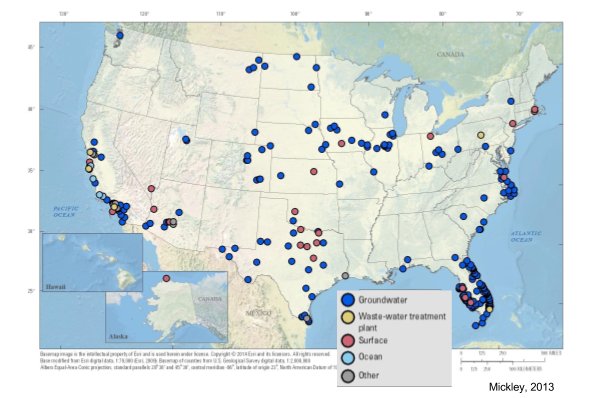This study, the first of its kind in more than 50 years, found that the amount of brackish groundwater underlying the country is more than 800 times the amount currently used each year. With issues like drought, groundwater depletion, dwindling freshwater supplies, and demand for groundwater expected to continue to rise, understanding brackish groundwater supplies can help determine whether they can supplement or replace taxed freshwater sources in water-stressed areas.
In general, brackish groundwater is groundwater that has a dissolved-solids content greater than freshwater but less than seawater. It is defined for this assessment as having a dissolved-solids concentration ranging from 1,000 to 10,000 milligrams per liter.
This new assessment was authorized by the 2009 SECURE Water Act and builds on a 1965 study which, for more than five decades, has served as the primary source of information on the national distribution of brackish groundwater. By incorporating data from more than 380,000 sites, compared to about 1,000 for the 1965 study, the 2017 assessment provides more comprehensive, nationwide data on the quantity and quality of brackish groundwater across the country. This includes information like chemical composition of the water and well yields, which are necessary for understanding the potential — at the National and regional scales — for expanding brackish groundwater development and for informing decision and policy makers.
All water naturally contains dissolved solids that, if present in sufficient concentration, can make the water brackish, or slightly salty. Sources of these dissolved solids can include ancient seawater, coastal seawater, dissolution of naturally occurring minerals, leaching from saline soils, road salt, brine from oil and gas wells, or other human activities.
The assessment provides data for states and other public agencies interested in using brackish groundwater. It also supports the efforts of the U.S. Bureau of Reclamation to promote sustainable water treatment for brackish aquifers. “The use of brackish groundwater to augment water supply in the West has been analyzed as a potential adaptation strategy in a number of studies under Reclamation’s Basin Studies Program,” said Katharine Dahm, an engineer with the U.S. Bureau of Reclamation.
Advances in desalination technology and increases in demand for uses that don’t need high-quality water, like mining, oil and gas development, and thermoelectric power generation, have led states like Texas and California to turn to brackish groundwater as an alternative to freshwater.
Data from the study released today indicate that brackish groundwater is present at some depth within 3,000 feet below ground beneath parts of every state except New Hampshire and Rhode Island. Using available data, a conservative estimate for the volume of brackish groundwater underlying the country is more than 35 times the amount of fresh groundwater currently used each year. Consequently, it is reasonable to consider brackish groundwater a substantial water resource available for use by the nation.
Despite the availability of this new information, there’s still more to uncover on sustainable development of brackish groundwater. For many locations, data haven’t been collected for depths greater than 500 feet. “Until recently, brackish groundwater has mostly been overlooked. It was difficult to find data for depths greater than 500 feet below ground in many parts of the country,” said Stanton. “More work is needed to fully understand the resource. Although this assessment can’t answer all of the questions related to sustainable use, it represents a starting point for identifying the gaps in our knowledge and for directing research to locations where further study would be most beneficial.”



 In some parts of the country, freshwater has become more limited and brackish groundwater use has been increasing. This graph shows the number of municipal desalination facilities through 2010. The blue line shows the number of facilities that are processing brackish water (mostly groundwater) and the red line shows the number of facilities that process seawater. Growth in brackish groundwater facilities is likely due to the fact that brackish water is cheaper to process than seawater and not limited to coastal areas. In 2010, there were 649 active desalination plants in the United States with a capacity to treat 402 million gallons per day. (
In some parts of the country, freshwater has become more limited and brackish groundwater use has been increasing. This graph shows the number of municipal desalination facilities through 2010. The blue line shows the number of facilities that are processing brackish water (mostly groundwater) and the red line shows the number of facilities that process seawater. Growth in brackish groundwater facilities is likely due to the fact that brackish water is cheaper to process than seawater and not limited to coastal areas. In 2010, there were 649 active desalination plants in the United States with a capacity to treat 402 million gallons per day. (